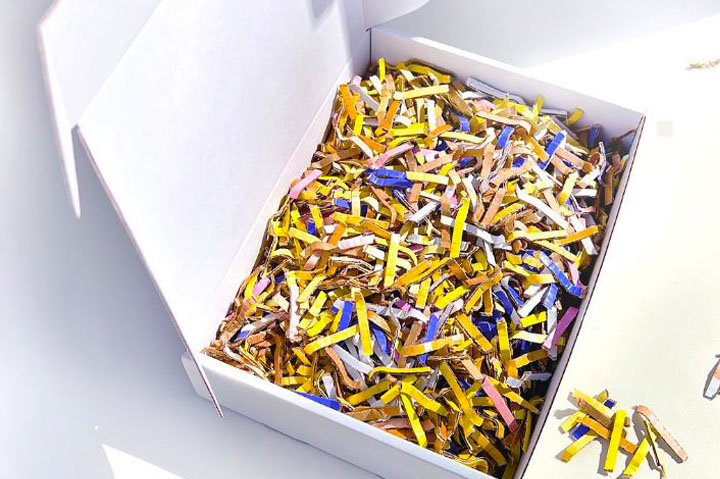Sustainability September 28, 2022
Chameleon Like Finds New Use for Old Boxes
Among the supplier’s many sustainable offerings is its “eco-shred,” a box filler made from post-industrial cardboard scraps.
Chameleon Like Inc. (asi/44558) hates to see a good thing go to waste.
“There’s very little that we throw away,” says Camila Linaweaver, general manager of the promotional products supplier that specializes in journals, portfolios and custom packaging. “Our goal is to recycle as much as possible anything that we can’t use, and anything that we can use in our manufacturing process, we use it. That’s really our sustainability approach.”

Chameleon Like takes scraps from corrugated boxes and runs them through an industrial shredder to make its “eco-shred” filler material.
The supplier, which is in the process of becoming certified as a B Corp, has robust post-production recycling programs at both its Gilroy, CA, and Houston locations. But it also looks at unique ways to repurpose materials within its manufacturing facilities. For instance, Chameleon Like takes the excess from its eflute box cutouts and runs it through an industrial shredder – turning the cardboard into “eco-shred,” a unique, eco-friendly packing filler. “People really love it,” Linaweaver says.
View this post on Instagram
For items that need more padding than shredded paper can provide, Chameleon Like offers custom black foam inserts that are both recycled and recyclable: It’s locally sourced and made from 90% waste and can be recycled after use as plastic #4, according to the company. Once the supplier has accumulated enough production scraps, the waste is sent back to the manufacturer for recycling, making it a circular product, Linaweaver says.
View this post on Instagram
Chameleon Like’s latest look book highlights many of the sustainable choices the supplier has been making. The company says it’s focused on making products domestically from locally sourced materials. In addition to its foam, paper, boards and inks come from domestic partners. Chameleon like has reduced the volume of imports from overseas from 12 containers a year to just six. Plus, 88% of its sales are Made-in-the-USA products. As part of its efforts to reduce plastic pollution, the supplier has reduced its use of single-use plastic packaging by 80% in five years.
The process of becoming a B Corp, Linaweaver says, “really forces you to take a look at your consumption … and your impact across your manufacturing.” During the impact assessment process, the supplier has installed sensor lights to reduce energy use, converted the lawn at its Gilroy, CA, facility to a rocky, desert landscape to reduce water consumption, and eliminated the use of paper towels among other changes.
What Can You Do?
Packaging waste is big problem – both from an environmental standpoint and combatting negative perceptions of the promo industry. Approximately 36% of all plastic produced is used to create packaging, 85% of which ends up in landfills, according to stats from EcoWatch.
Try these strategies to reduce packaging waste.
- Avoid single-use plastic packing materials. Chameleon Like’s eco-shred material made of post-industrial shredded cardboard is one sustainable option for kitting non-breakable materials. Other companies offer flexible protective packaging made from recycled paper, like Cushion Lock protective wrap from Scotch, which expands and conforms to a product to keep it safe during shipping. The material can easily be recycled curbside after use.
- Opt for polybag alternatives. Clear plastic polybags help keep items like T-shirts from getting dirty or weather-damaged during transit. Consider swapping out traditional bags with 100% recycled clear bags when possible, an option preferred by sustainable shipping company EcoEnclose over compostable bioplastic bags. “By creating products out of the recycling waste stream, you actually strengthen your ability to recycle because you help create the markets that are necessary to driving the recycling supply chain,” according to a blog post from the company.
- Right-size your packaging. Shipping items in boxes that are too big increases your carbon footprint – and your costs – over time. Instead, look for ways to be more efficient in what you send. When possible, consider using a mailer made of recycled materials, rather than a box. Mailers use less material than boxes and take up less “dead space” on delivery trucks.

Promo for the Planet is your destination for the latest news, biggest trends and best ideas to help build a more sustainable and socially-responsible industry.
